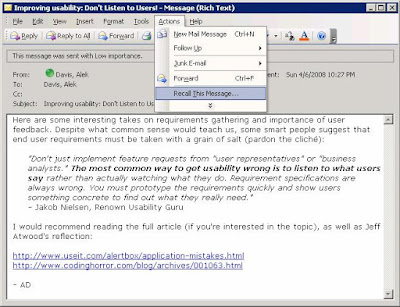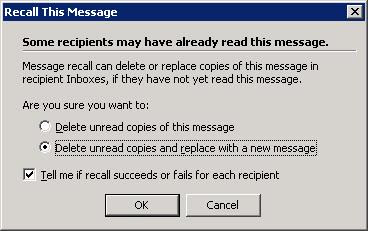Email etiquette: how to recall a message
Summary: Five courtesy rules of email message recall applicable to Outlook users (but not only).
It happened to me again: I sent an email to a (reasonably) large group of people and then realized that I forgot to include an important detail. What do I do now?
I could do the following:
- Send an updated e-mail containing original message along with additions.
- Send an update with a reference to the original message (not including the original message).
- Use Outlook's capability to recall the message and replace it with a new one.

Well, despite my best intentions, I did not do it right again, because several recipients had already opened the original message and weren't sure whether they needed to finish reading it or start over. Since this happened to me more than once, I thought I would define a few guidelines for doing it right. I hope they will help you as well.

Here are the five rules of email revocation etiquette I recommend:
- Don't send the message right after completing the last sentence.
Unless the message is urgent, do not send it immediately after writing. Give yourself a 5-10 minute break, then re-read it from beginning to end (do not rush), check hyperlinks (if you use hyperlinks, click every one of them to verify that they point to the correct sites), and only then send it. - Pick the right option to recall/resend the message.
OK, you did not follow the first rule (or you did but then realized that you still needed to change something), so now you need to decide how to send an update: either by recalling the message, sending an update, or sending an update with the original message. First, keep in mind that the Outlook's message recall may not always work (see the Will my recall be successful? section). Second, consider time. If you sent the original message more than a few minutes ago (unless you did it in the middle of the night and all recipients live in your time zone), message recall will do little good. I suggest that you recall email only within the first 5-10 minutes of sending the original message or when there is a high probability that the majority (I would say 95%) of recipients did not have a chance to open it. If it's likely that people has already started reading the message, don't try to recall it, just send an update. - Modify the subject line.
Keep in mind that message recall may work for some recipients and not for others. If you send an update (either via recall/replace or standard resend), indicate that this message is an update. Include an update indicator in the subject line, e.g. you can add the word [UPDATED] (with brackets) in the beginning or at the end of the subject phrase, such asSubject: [UPDATED] New training requirements
orSubject: New training requirements [UPDATED]
- Explain the changes.
To help those who have already read the original email, add a sentence (or brief paragraph) in the beginning of the message stating that this message is an update; describe the nature of the update. If the original message contained errors (e.g. a broken hyperlink), fix the original message (the part which was wrong). For example, you can start the message with the following paragraph:[UPDATE]In case you received my first message: the URL of the training company XYZ was wrong. I'm resending this message with the correct URL. Sorry for confusion.[/UPDATE]
When adding new information (say, a new hyperlink), you can either include it in-line or add it in the beginning, e.g.:[UPDATE]In case you received my first message: I forgot to include the URL of the training company XYZ, which is: http://UrlOfXyz. Sorry about that.[/UPDATE]
If you add new information in-line, make it stand out (if you use rich text or HTML formatting, mark it using a different font style or some other indicator), such as:Here is the list of approved training companies:
http://UrlOfABC
http://UrlOfDEF
[ADDED]http://UrlOfCompanyXYZ[/ADDED] - Be careful with them attachments.
If the original message contained attachments, be very careful: do not include very large attachments in the update because it will take space on the server and fill recipients' mail boxes with duplicate data. If the attachments are reasonably small, you can assume that (or ask) recipients (to) delete the original message.
How to use the recall message feature in Outlook 2000 or in Outlook 2002

thanks for such a nice tip
ReplyDeletei faced the same problem while sending my b'day emails to my friends